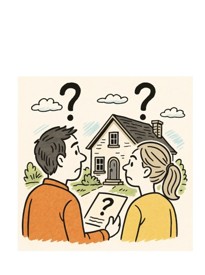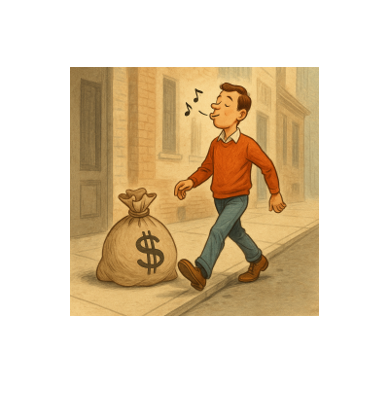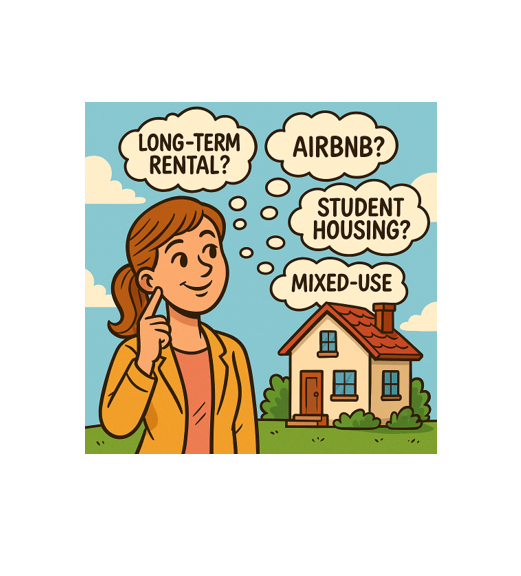Weekly Blog #8
“Price is what you pay. Value is what you get.” Warren Buffett
Adam Smith’s invisible hand tells us that in a free market, prices are set by what a buyer is willing to pay and a seller is willing to accept. And for many goods and services, that’s true enough. But real estate is different. A buyer may be willing to pay $500,000 for a home, but if the bank won’t finance 80% of that amount, the deal’s dead in the water. Unlike a pair of shoes or a share of stock, the value of a property often depends on more than just market sentiment—it depends on lending standards, appraisals, income potential, and cold, hard math.
So, what’s a house really worth? It depends on who’s asking—and why. From comps to replacement cost, from cap rates to discounted cash flow, there’s more than one way to size up a property’s value. Let’s break it down.In residential real estate, the most common method of valuation is a comparative market analysis (CMA), or “comps.” This approach compares recent sales of similar homes in the same area—adjusting for variables like size, condition, lot, location, and upgrades. It’s the real estate equivalent of pricing a used car on Kelley Blue Book.
But comps are only as good as the market they’re based on. In a hot market, buyers may overpay because they’re emotionally driven or fearful of being priced out. In a cold market (think 2009–2011), even desirable homes may sit unsold. In other words, comps reflect what someone was willing to pay—not necessarily what something is intrinsically worth.
If you’ve ever heard someone say “a house is worth what someone’s willing to pay for it,” they’re quoting the comps model. But that’s a bit like saying a donut is worth $20 because someone on a hunger strike finally cracked. Not exactly an objective measure.
Another method is replacement cost—how much it would cost to rebuild the property from scratch, using current labor and material prices. This is the method used by insurance companies when underwriting homeowners’ policies. It’s especially useful in post-disaster situations where the land value is unchanged but the structure must be replaced.
Here’s the catch: replacement cost ignores land value and market demand. A custom-built log cabin on the edge of nowhere might cost $500K to recreate, but if nobody wants to live there, good luck selling it for anything close.
For investment properties, valuation is typically driven by the income approach. This method assesses what a property is worth based on the income it generates. The most common metric used to analyze investment properties is the Capitalization Rate (Cap Rate). The formula is simply; Cap Rate = Net Operating Income (NOI) ÷ Market Price
A rental property producing $70,000 in net annual income and priced at $1 million has a 7% cap rate. Higher cap rates mean higher yield—but often higher risk. Lower cap rates usually reflect stronger locations or more desirable properties.
Cap rates are a function of interest rates, and historically run 250–350 basis points above the 10-year Treasury note yield. This 2.5–3.5% spread reflects the required risk premium. Real estate investors require in order to take the risk of investing. As of today, the 10-year yield is ~4.5%, which means a prudent investor should seek a cap rate north of 7%.
This model is especially relevant for investors focused on cash flow. If a property’s net income doesn’t justify the price tag—especially when compared to other investments with similar risk profiles—it’s overpriced.
The DCF method attempts to model the present value of future cash flows, discounting them at an appropriate risk-adjusted rate. Think of it as the cap rate model on steroids. It’s ideal in theory—and often a mess in practice—because it’s highly sensitive to assumptions about rent growth, vacancy rates, exit cap rates, and discount rates.While models and math provide the scaffolding of valuation, real estate—especially residential real estate—is emotional. A young couple might stretch their budget for the perfect backyard. A retiree might pay a premium to be near grandkids. A tech exec might drop $5 million on a teardown in Palo Alto just because it’s Tuesday.
Scarcity also plays a role. In markets like Boise, Austin, or Salt Lake City—where housing supply lags population growth—prices are driven higher not because homes are worth more, but because there simply aren’t enough of them.
And let’s not forget the biggest wildcard of all: interest rates. A home priced at $500,000 with a 3% mortgage feels very different than the same home with a 7% mortgage. Housing affordability isn’t just about price—it’s about monthly payment.
So… What’s it worth? It depends who’s asking.
- To the buyer, it’s worth what they can afford—and justify.
- To the appraiser, it’s worth what the comps suggest.
- To the insurer, it’s worth the replacement cost.
- To the investor, it’s worth the present value of future cash flows.
- To the market, it’s worth whatever clears the transaction.
Real estate value isn’t fixed—it’s a moving target shaped by macroeconomics, local market trends, interest rates, and emotion. It’s part science, part art, and part psychology.
At Wasatch Finance, we believe valuation should be grounded in fundamentals, not hype or emotion. Whether you’re buying a primary residence, flipping a property, or analyzing a rental deal, our job is to help you ask the right questions—and run the right numbers. Because in real estate, as in life, knowing what something is really worth makes all the difference.
Mark Lazar, MBA
CERTIFIED FINANCIAL PLANNER™









